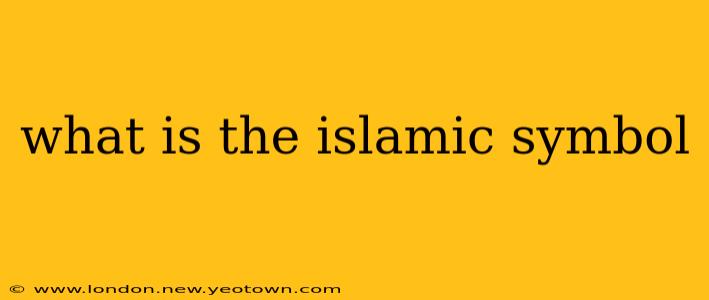The question "What is the Islamic symbol?" doesn't have a single, definitive answer. While the crescent moon and star are widely recognized as a symbol associated with Islam, it's crucial to understand that it's not an official religious symbol in the same way a cross is for Christianity. Many symbols hold significance within Islam, representing different aspects of faith, history, and culture. Let's explore some of the most prominent.
The Crescent Moon and Star: A Widely Recognized, but Not Universally Accepted Symbol
The crescent moon and star are arguably the most internationally recognized symbol associated with Islam. However, its origins are not purely Islamic. The imagery predates Islam and has been used by various cultures and empires throughout history. Its adoption by Muslim communities is believed to have begun in the Ottoman Empire, and its widespread use solidified over centuries. While many Muslims see it as a representation of Islam, it's important to note that it's not mentioned in the Quran or Hadith (the sayings and traditions of Prophet Muhammad). Some Islamic scholars even argue against its use as an exclusive symbol of the faith.
The Symbol's Diverse Interpretations:
The meaning ascribed to the crescent moon and star varies. Some interpretations include:
- The New Moon: Symbolizing new beginnings, renewal, and the cyclical nature of life.
- Guidance and Light: Representing guidance and illumination, mirroring the teachings of Islam.
- The Night Journey (Isra and Mi'raj): Referencing Prophet Muhammad's miraculous night journey to heaven, often associated with the celestial imagery.
Therefore, while widely used and recognizable, it's not a universally accepted or mandated symbol within Islam.
Other Significant Symbols in Islam:
Beyond the crescent moon and star, several other symbols hold deep meaning within the Islamic faith and culture:
1. The Shahada (Islamic Declaration of Faith):
This is the most fundamental symbol of Islam, encapsulating the core belief: "There is no god but God (Allah), and Muhammad is the messenger of God." Reciting the Shahada is the first pillar of Islam and is a declaration of faith. While not a visual symbol in the same way as the crescent moon, it represents the very essence of Islamic belief.
2. The Kaaba:
Located in Mecca, the Kaaba is a cube-shaped building and the most sacred site in Islam. Millions of Muslims perform Hajj (pilgrimage) to Mecca each year, circling the Kaaba as a central ritual. Pictures of the Kaaba are often displayed as a symbol representing the direction of prayer (Qibla) and the centrality of Mecca.
3. The Mosque:
Mosques serve as places of worship, community gathering, and learning for Muslims worldwide. The architecture and design of mosques often reflect Islamic art and cultural heritage. While not a symbol in the same sense as others, the mosque’s presence acts as a potent visual representation of Islamic communities globally.
4. The Arabic Calligraphy:
The art of Arabic calligraphy plays a significant role in Islamic culture and is seen as a sacred form of artistic expression. Verses from the Quran, the names of Allah, and other religious phrases, when artistically rendered, become symbols of faith and devotion.
Conclusion: Understanding the Nuances of Islamic Symbolism
It's essential to approach the topic of Islamic symbols with sensitivity and respect. The crescent moon and star are commonly associated with Islam, but their usage is not universally agreed upon within the faith. The true essence of Islam lies in its core beliefs and practices, rather than any single symbolic representation. Understanding the diverse array of symbols within Islamic culture provides a richer appreciation for its history and beliefs.

